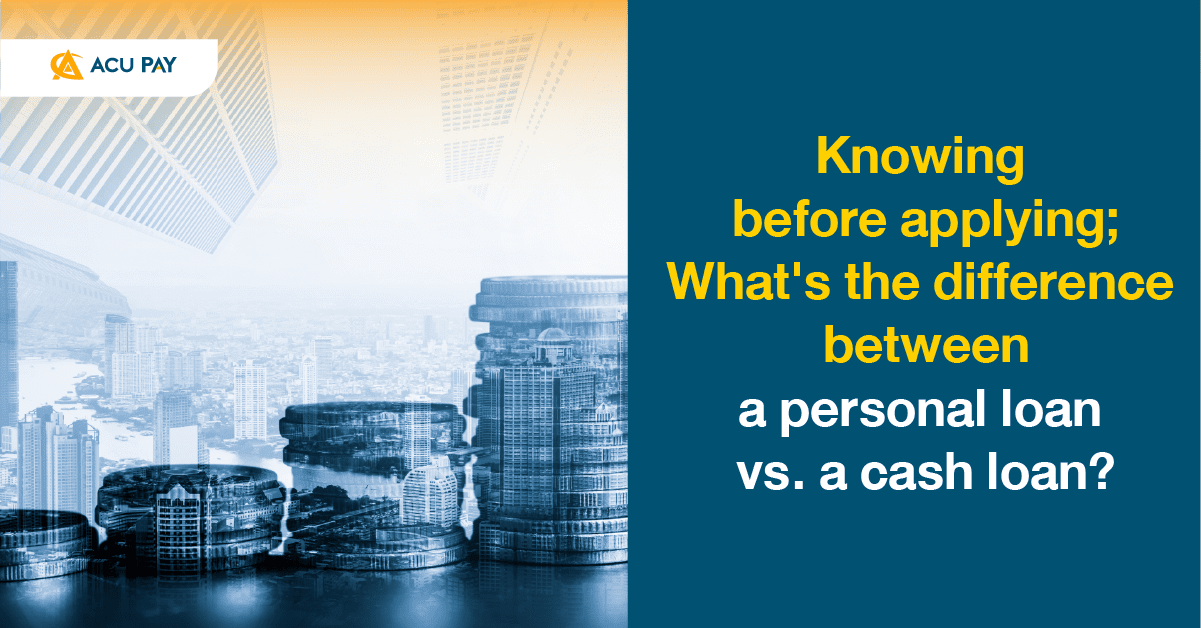

A lot of people who are not having enough money to use will rely on borrowing like loans or withdrawals from credit cards. Do you know what kind of financial products are right for you? This time, ACU PAY will introduce you to two types of loans: personal loans and cash loans.
Personal loans and cash cards are among the financial products provided by banks or financial institutions. Many people may wonder what the difference between cash cards and personal loans is in terms of loan patterns, interest rates, and repayments.

Loans issued by credit providers, both banks and non-bank financial institutions, in cash forms. Once approved, funds will be transferred to the bank account. It is an alternative for those in need and looking for large sums of money such as medical expenses, home repairs, and family expenses. There can be divided into 2 types:
– A personal loan with collateral property is a loan in which borrowers have to take securities such as land, houses, buildings with a value greater than or equal to the amount of loans that they apply for.
– A personal loan without collateral property is a loan in which borrowers do not need collateral, and only show evidence of their income, but the loan interest is often more expensive than collateral loans.
Personal loans are suitable for fixed-income employees such as company employees, government officials, and state enterprise officers with incomes of 15,000 baht or more. The loan is suitable for those who want to use it for investment, business liquidity, or expansion.
Interest rates not exceeding 25% per annum and are calculated as an effective interest rate, but personal loans with registered cars as collateral must calculate the interest at no more than 24% per annum.
Interest will be charged from the date the bank transfers money to the applicant’s account. However, if you pay more in each installment, interest will be reduced.
According to the loan agreement with the bank, repayment is scheduled from 12 – 60 months (depending on the borrower’s choice of repayment period) This allows them to set a time limit and plan their loan payments. However, if they have a large sum of money, they can also use it to close the loan.
A cash card is a loan in the form of a card issued by a bank or financial institution to a loan borrower to withdraw cash at the ATM according to the approved limit in the cash card. The cardholder can withdraw cash at any time without any minimum requirement. However, the amount of money that can be pressed must not exceed the amount approved by banks or financial institutions.
Most cash cards are not eligible for purchases of goods or services, except for some cash cards that can be used to pay installments, depending on promotions and conditions of the stores and financial institutions.
People who want to increase their liquidity or need cash during urgent times without the need for security or guarantors such as medical expenses, repairs, and other special occasions such as school fees, water bills, electricity bills, and rentals. Cash cards are available daily through ATMs nationwide 24 hours a day.
The maximum interest rate is not more than 28% per annum because the cash card is a personal loan that does not require a guarantor or has property as collateral, making the interest rate slightly higher than other types of loans.
Interest and fees will only be calculated from the date and based on the amount we’ve been withdrawn.
The payment method is similar to a credit card. When the bill is made, borrowers can pay their full amount or choose to pay the minimum amount like a credit card. After paying, they will get the financial limit back and be able to use cash cards again.
Personal loans and cash cards have different advantages and disadvantages.
The advantages of “Personal Loan”: The approval amount is relatively high, but usually not more than five times the salary. The maximum length of installment is 60 – 72 months, depending on each bank. Interest rates are lower than cash cards.
The disadvantages of “Personal Loan”: It should be used when necessary because the bank will charge interest as soon as the credit limit is approved and transferred to our account. There may be fees and other expenses incurred in borrowing.
The advantages of “Cash Card”: It is easy to use and convenient to simply withdraw your cash at the ATM. Moreover, interest and fees will be charged based on the actual amount, no minimum withdrawal limit and no fee will be charged.
The disadvantages of “Cash Card”: Convenience of use may lead to excessive debt and higher interest rates on cash cards than personal loans, which require discipline in repaying the principal and interest.